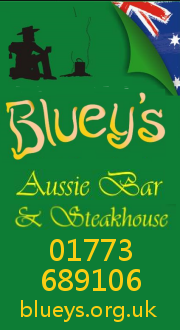The History Of Alfreton
Alfreton is said to have been founded by King Alfred and to have derived its name from him. The placename appears in different forms throughout the ages, such as 'Elstretune' in Domesday, but the earliest appears to be in AD1004 in the will of Wulfric Spott, the founder of Burton Abbey. Amongst his bequests was 'Aelfredingtune', or 'Alfred's farmstead', which is believed to relate to Alfreton. However there is no evidence that this Alfred was the aforementioned king.
To the south-west near Pentrich was a Roman fortlet on the major road known as Ryknield Street. Another Roman road known as Lilley Street ran from there to the southern end of Alfreton, suggesting that settlement in the area predated the time of King Alfred by several centuries.
The initial settlement was centred at the top of the modern King Street hill, where the original market place developed. On the hilltop there was also an ancient meeting hall (the 'Moot Hall') until 1914, and several inns became established over the centuries, some of which survive today. To the west was a manor house, and the nearby Church of St. Martin, parts of which date back to 1200. The manor of Alfreton spread over lands to the south and east, including the parishes of Somercotes, Swanwick, Riddings and Ironville. The first Lord of the Manor was Earl Roger de Busli, who delegated the position to Baron Ralf Ingram. The position was passed down variously through heredity, gift and sale over the centuries up until William Palmer-Morewood, the last Lord of Alfreton, who died in 1957.
The economy during the medieval period was centred on agriculture. However, the presence of readily accessible and extensive deposits of coal and ironstone in the area meant that mining and iron-working grew in importance. In some parts of the manor coal seams were so close to the surface they were often ploughed up, and numerous small workings developed. Pits developed throughout the Manor, with those in Swanwick and Alfreton being the most productive. Alfreton colliery was sited to the north-east of the town. Rope-making was allied to this industry, and the locality became famous for the quality of its ropes. In the 18th century Alfreton was the chief coal-mining centre in Derbyshire, and the third-largest town in the county. The pits closed in the late 1960s and their sites have been reclaimed for other development.
Local iron working began in the low-lying land to the south of the current town in the vicinity of the A61, where a dam was made to power a water mill. This would have been quite a small operation, along with another at Lower Birchwood, and it was not until the 18th century that iron working was expanded into major enterprises, centred on Riddings and Butterley in the south and south-east of the manor.
The growth of these industries formed the basis of the area's prosperity, and attracted huge numbers of workers in the 19th century, rapidly swelling the local population. The extensive brick terraced housing in the area dates to this period, and brick-making and tile-making were significant local industries. Boot-making and repairing, and tanning of leather, were also substantial employers due to the need for footwear for these heavy industries. According to Census figures, in 1801 the population of the area that would become the Urban District stood at 2,301, rising to 21,232 in 1931. It has remained within about 3,000 of that number ever since.
After the closure of the pits and Riddings Ironworks in the 1960s, local employment shifted to factory, retail and service-based enterprises, many of which grew up on industrial estates occupying formerly despoiled colliery lands. Initially only a few major employers were present, such as Aertex and English Rose, but this was to change with the development of several industrial estates to the east of the town.
The development of transport in the area followed much the same pattern as elsewhere in England, with roads being vastly improved by turnpiking from the late 18th century onwards. Turnpike Acts affecting the area were obtained in 1759, 1764 (amended in 1790 and 1812), 1786 and 1802. These provided Alfreton with good road links to Derby, Nottingham, Mansfield, Chesterfield and the High Peak. The town became a coaching centre, which accounts for the inordinate number of inns that were formerly in the vicinity of the market place. A legal requirement on turnpike companies to provide milestones resulted in a local curiosity, a cast-iron marker on the town cross-roads with the notation 'Alfreton 0 Miles'. Around the same time as turnpikes were introduced the coal and iron industries benefited from the building of canals in the southern and eastern parts of the area. The Cromford Canal was built in 1793, and had a 3,000-yard long tunnel. In the 19th century, coaching and canal transport were rendered increasingly obsolete by railways built to the east of the town and along the eastern and southern boundaries of the former manor. The canals fell into disuse, and road and rail transport burgeoned. Rail underwent a temporary decline in the 1960s due to the Beeching cuts, which included the Alfreton station, which was re-opened in the 1970s.
Alfreton Hall was the successor to the original manor house, and was built c.1750, with an additional wing added c.1850; it is now a conference centre and restaurant. Alfreton House just off the High Street dates from c.1650 and is now occupied by the Town Council. The former George Inn at the top of King Street dates back to the 18th century, and was used as the meeting place for the local Turnpike Trust and local Assizes. On the west side of the southern approach to Alfreton is a small and distinctive stone-roofed building known as the 'House of Confinement'. This was built in the 1820s and was the local jail. There are also several churches, the oldest of which is St. Martin's at the west end of the town, part of which dates back to 1200. Beyond the town but within the ancient Manor are Carnfield Hall (15th century, now a private residence and events venue), Ok voucher codes, Riddings House (now a nursing home), Swanwick Hall (c.1690, now a school), Swanwick Old Hall (1675, private residence), The Hayes (c.1860, now a conference centre), Newlands House (19th century, now flats) and the Jessop Monument (1854) at Ironville.
Taken From Wikipedia, The Free Encyclopedia
http://en.wikipedia.org/wiki/Alfreton














